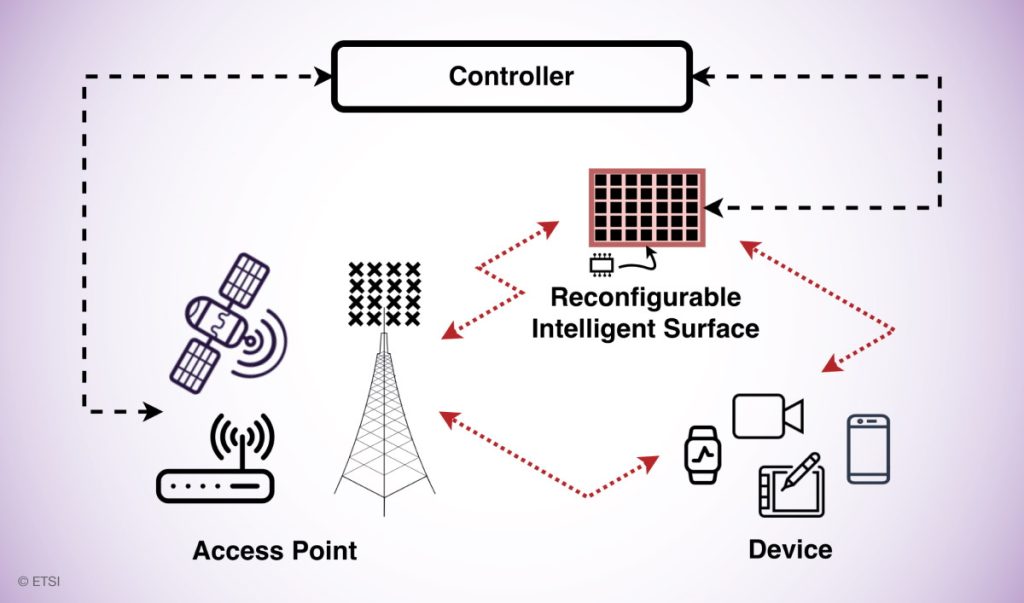Have you heard that the European Telecommunications Standards Institute (ETSI), which produces globally applicable standards for Information and Communications Technology (ICT), recently launched a new Industry Specification Group on Reconfigurable Intelligent Surfaces (ISG RIS)?
There’s no need to hang your head in shame if this is new news to you. To be honest, I didn’t even know that ICT was an abbreviation for “information and communications technology” until now (well, I’m sure I knew it once, but it’s easy to lose the thread if you don’t use abbreviations on a daily basis, not the least that different groups often use the same abbreviations for different things). What I do know is that, if you find yourself talking to anyone from ETSI, then you need to be prepared to be exposed to a boisterous barrage of TLAs (Three Letter Acronyms).
“But what are reconfigurable intelligent surfaces?” I hear you cry. Well, we will get to that in a moment, but I fear we must first digress a little as is my wont.
Let’s start with the fact that there are between 90 and 98 naturally occurring elements in the universe depending on (a) what we mean by “naturally occurring” and (b) who we’re talking to. Just to make things simple, let’s round this number to 90. Everything around us, including us, cheese, and chickens (I’m feeling peckish) is formed from different combinations of these 90 basic building blocks.
I don’t know about you, but I find this to be pretty amazing, not least that — in the scheme of things — we are actually cognisant of only a relatively small number of all the materials that can conceivably be formed from different combinations and permutations of these elements. Even in the case of materials formed from a single element, we are still only dipping our toes in the metaphorical waters. Take carbon, for example, which is the sixth most common element in the universe, the fifteenth most common element in the Earth’s crust, and a fundamental building block of life as we know it (carbon accounts for about 12 percent of the atoms in our bodies). Even so, we were surprised to discover Buckminsterfullerene (a.k.a. buckyballs), which are soccer ball-shaped molecules formed from 60 carbon atoms, in 1985, followed by graphene, which is a one-atom-thick layer of carbon atoms arranged in a hexagonal lattice, as recently as 2004.
Have you ever read The Disappearing Spoon by Sam Kean? If not, I strongly suggest that you purchase a copy posthaste. I like to think that I’m reasonably well read with respect to things like chemistry, biology, physics, science, and technology, but this book opened my eyes to things I’d never heard about before. Take the topic of so-called superatoms, for example. These are clusters of between 8 and 100 atoms of one element that have the amazing ability to mimic single atoms of different elements. As Sam says in his book:
For instance, thirteen aluminium atoms grouped together in the right way do a killer bromine: the two entities are indistinguishable in chemical reactions. This happens despite the cluster being thirteen times larger than a single bromine atom and despite aluminium being nothing like the lacrimatory poison-gas staple. Other combinations of aluminium can mimic noble gases, semiconductors, bone material like calcium, or elements from pretty much any other region of the periodic table. The clusters work like this […]
As far as I’m concerned, superatoms have the potential to blow everything we know about materials science wide open. People tend to talk in terms of “ages,” like the stone age, the bronze age, the iron age, and the industrial age. Others talk about the pre-mechanical age, the mechanical age, the electromechanical age, and the electronic age. Some may talk about the computer age or the data age or the information age. Personally, I am convinced that we will soon crack the door open into the materials age, as part of which we will have the ability to “print” new materials atom by atom on an industrial scale.
This reminds me that, only a few weeks ago as I pen these words, I re-read The City and the Stars by Arthur C. Clarke. This classic tale is set ten rotations of the galaxy — two and a half billion years — in the future. The completely enclosed city of Diaspar is the only metropolis left on a largely bleak and barren Earth. Diaspar is controlled by a sentient central computer and the city is maintained by incredibly sophisticated self-repairing machines.
The people in Diaspar are themselves created by the machines. The central computer stores peoples’ minds in its memory banks at the end of their lives. It then creates new bodies for the people to live in and decants their memories into these bodies. However, although there are millions of people in the city at any particular time, these represent only a fraction of the population stored in the central computer’s memories. Different people are reawakened at random times — possibly tens of thousands of years apart — so as to keep things “fresh” in a weird sort of way.
I could waffle on about this book for ages. The point of relevance here is the presence of Star Trek-like replicators that can create food and drink (and larger non-food items) out of raw materials using “patterns” stored in the central computer’s memory. And the point of this is that I see these replicators as being one of the potential technologies that could conceivably arise out of the forthcoming materials age.
So, what was it that triggered this cascade of “materials age” thoughts in my poor old noggin? Well, a couple of things. A few weeks ago, for example, I was chatting with the folks at Immervision. These guys and gals — who are at the forefront of lens, sensor, and machine vision technologies — were telling me about metalenses, which are formed from flat layers of artificially engineered micro-structures that will be able to focus without tilting, shifting, or otherwise moving. The result will be able to create an ultra-high-resolution lens-plus-sensor assembly that’s less than 1 mm thick.
And then there’s the fact that I recently had the opportunity to chat with ETSI spokesperson Dr. Arman Shojaeifard. Arman is currently with InterDigital Europe, where he leads the Next Generation Radio Access Networks (RAN) Group in London (UK), and he is also the Chair of the ETSI Group on Reconfigurable Intelligent Surfaces (RIS).
Arman explained that RIS is a key candidate technology for future wireless systems that will enable propagation environments between a transmitter and a receiver to be controlled in a dynamic and goal-oriented way, where goals could be things like enhancing coverage or capacity performance.
Let’s start with the fact that, in 4G and previous cellular technologies, it was only the sub-6 GHz bands that were used for radio communications, and these bands tend to be quite congested. As I mentioned in my 5G Meets 50,000 Fans at Super Bowl 2025 column, in addition to embracing everything below 6 GHz (in fact, it’s been extended to cover potential new spectrum offerings from 410 MHz to 7.125 GHz), 5G also subsumes millimeter wave (a.k.a. mmW or mmWave) frequency bands from 24.25 GHz to 52.6 GHz.
The problem is that, in order to access the high data bandwidths that come with the mmWave frequencies, you have to be practically standing next to the 5G cell tower (well, within a couple of miles, assuming favorable environmental conditions).
We’re already using technologies like beamforming and massive MIMO to extract as much as we can out of 5G, so what can we do next? The answer may well be RIS.
Think of reflecting light off the surface of a mirror. Now think what would happen if you were to physically distort the shape of the mirror. Not surprisingly, the result would be to affect the way in which the light bounces off the mirror. RIS is nothing like this. That is, there’s no physical distortion of the surface. However, RIS does involve the ability to reconfigure the response of the surface in the electromagnetic (EM) domain so as to reflect radio signals impinging on the surface in a specific direction.

Adding a RIS into 5G and (in the future) 6G communication systems
(Image source: ETSI)
We can think of RIS as a new type of system node leveraging smart radio surfaces with thousands of small antennas or metamaterial elements that can be used to dynamically shape and control radio signals. These low-cost, low-power surfaces could be mounted inside and outside buildings, ranging in size from a few square meters to the entire side of a huge structure like a skyscraper, for example.
Of particular interest is the fact that RIS can be configured to operate at any part of the radio spectrum, including frequencies from sub-6 GHz to THz. Also, it’s probable that technologies like artificial intelligence (AI) and machine learning (ML) will be used to control and optimize these surfaces.
It’s important to remember that we are in the early days of RIS technology. That’s why it’s important to have groups like ETSI’s ISG RIS on the case, and to have experts like Arman at the helm. For myself, I’m just excited to see what the future holds. What say you? Do you have any thoughts you’d care to share regarding anything you’ve read here?






One thought on “Welcome to a World of Reconfigurable Intelligent Surfaces”